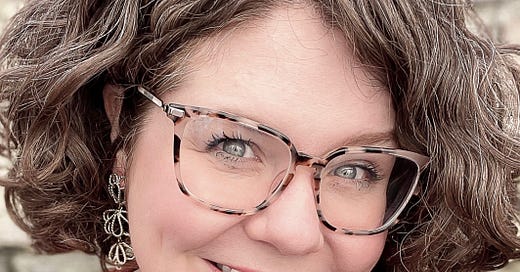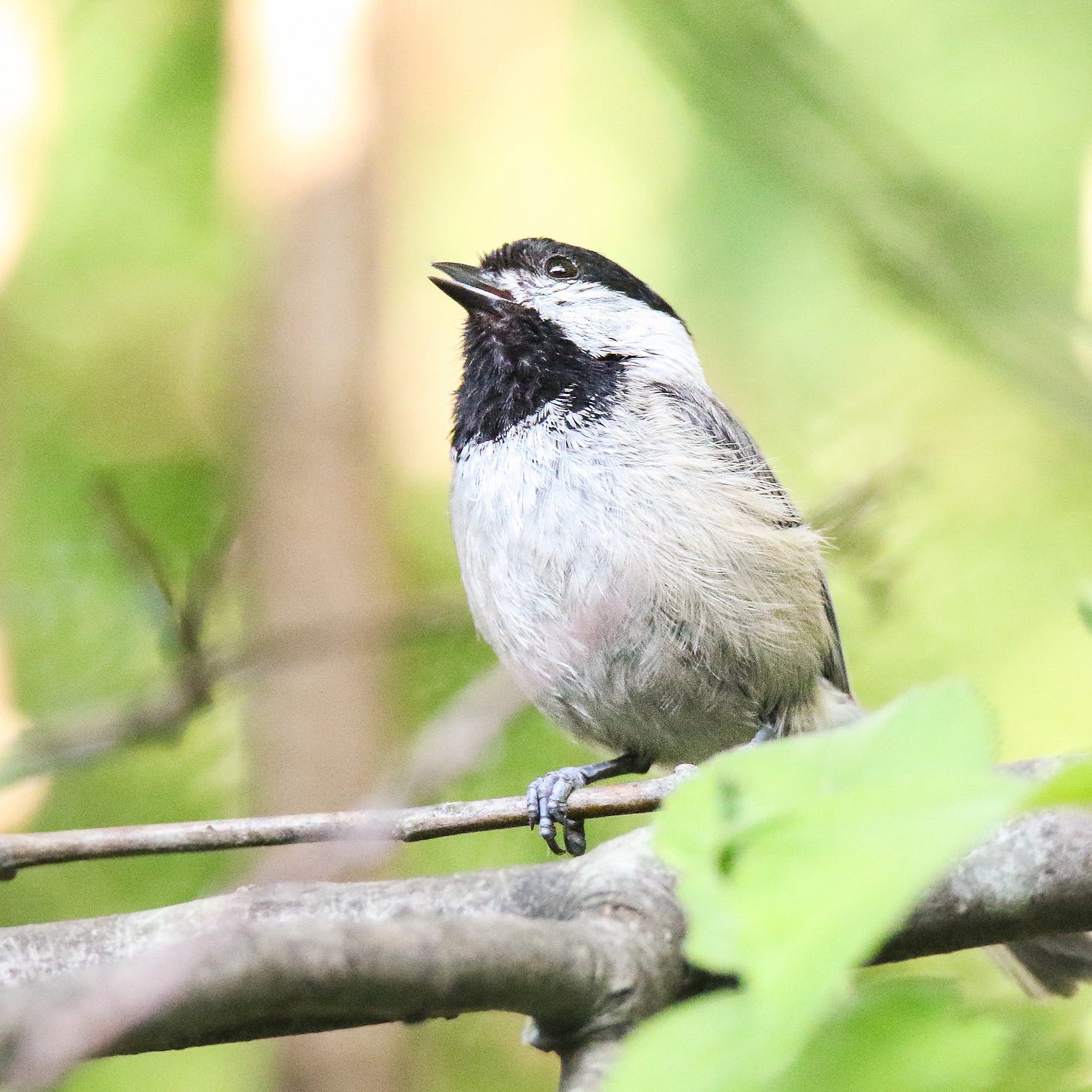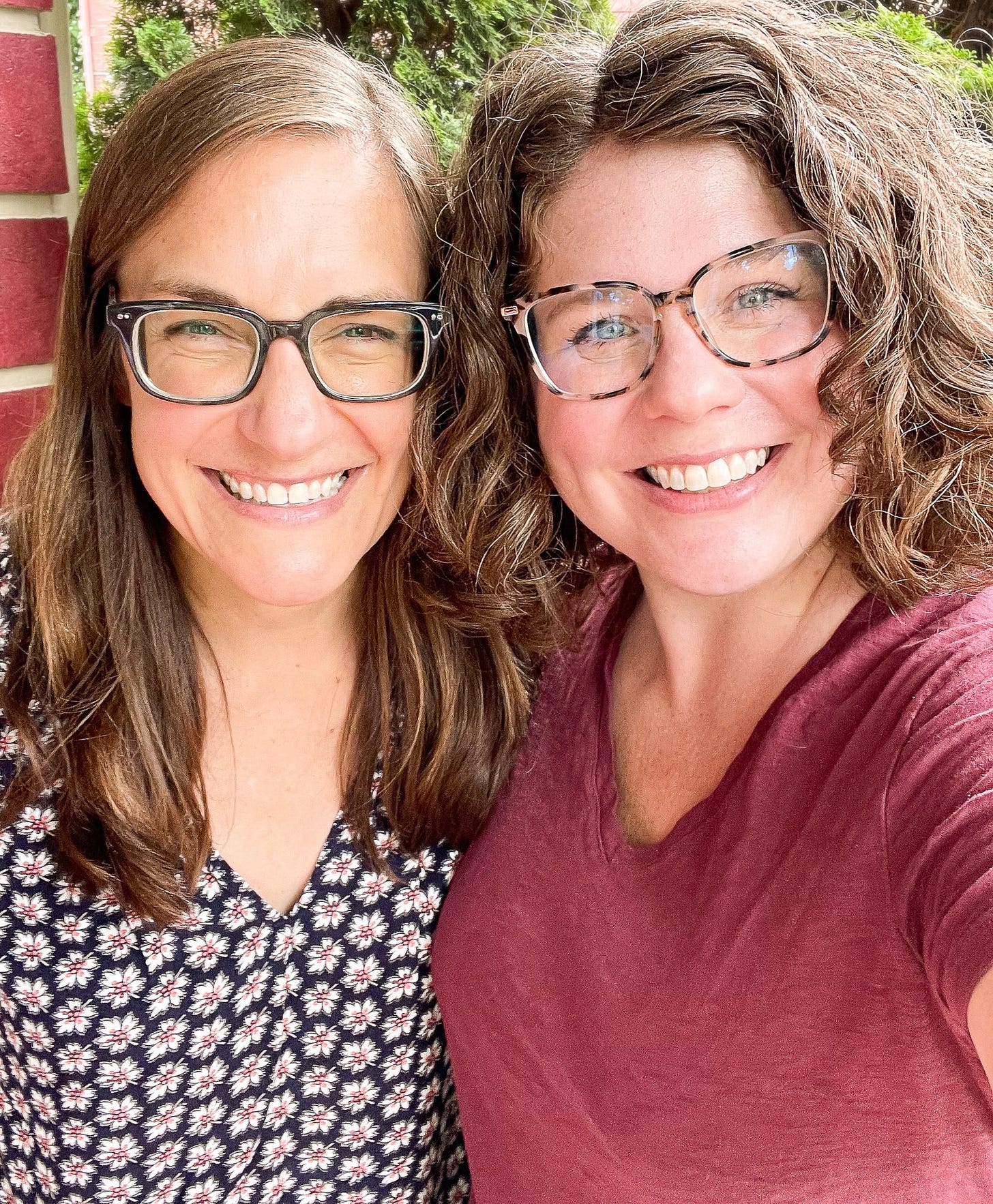The Life-Changing Magic of Singing Along
a guest essay by poet, teacher & suburban wildlife photographer, Violeta Garcia-Mendoza
Today, I’m excited to share a guest essay by Violeta Garcia-Mendoza that considers music as mindfulness, as protection spell, as survival. I’d love your suggestions of other writers, artists, practitioners, and wise humans I might feature here. You can just reply to this newsletter with ideas. 📝
I first met Violeta Garcia-Mendoza on Zoom in Fall 2021 in my Madwomen in the Attic poetry workshop and she has been a keystone of my Madwomen workshops ever since. Long before I met her in person, I looked forward to seeing Violeta every week in her Zoom box, always early to workshop no matter what chaos was going on in her life—with her warm smile, quick wit, tortoise shell glasses, and one of her many rescue dogs popping in and out of the frame. I think my first real memory of Violeta, though, is of the poem that became “Soundscape” in her debut collection, Songs for the Land-Bound, just out with June Road Press. I remember being startled by the line, “Call it music, all of it.” In a poem that includes Minecraft zombie sound effects, hockey play-by-plays, and the toilet running, Violeta created this chaotic collage of sounds, and then with six short words, deemed it all “music.” That line hit me viscerally in the midst of my loud, busy office. What if I called it all music?
Violeta’s poems have always felt like songs to me. Carolyn Oliver writes that Violeta's first book is “a meadow humming with life, and an incantation for the preservation of wonder.” Chloe Martinez writes that “in these wise poems the way we live is situated squarely in the wounded, beloved world.” If you haven’t encountered Violeta’s work yet, I hope this essay will help you discover it. Here, Violeta shares a harrowing experience of her initial Type 1 diabetes diagnosis, and how music became a grounding practice for her in her daily life. Read on, friends, for Violeta’s stunning essay and a music & mindfulness prompt that might be exactly what you need right now. 🎶
Violeta on The Life-Changing Magic of Singing Along
The first time I remember forgetting how to breathe was on the eve of my twelfth birthday, when I had already been mysteriously ill for some time. I remember the feeling of a snake thickening my sternum, my heartbeat wrong, my mother’s bedroom shimmering.
Too long undiagnosed with Type 1 diabetes, the sugar in my bloodstream built up like poison. My body tried to breathe off the acidosis, breathing too fast, then too slowly. Kussmaul breathing, as I later learned it was called, is a sign of imminent coma or death in diabetic patients. In some medical literature it’s described as a desperate air hunger. The patient’s breath smells like fruit, and it was because of this that, even before any blood tests came back, an emergency room physician diagnosed me by his senses and started to save my life.
I don’t remember anything from the ambulance ride to two days later. Sometimes the mind draws its dark curtain and you have to trust it’s a protection.
But still, the body, in its own ways, remembers. Maybe it was through that incident that my body learned that, despite all the other signs, my breath was what finally caught the attention needed to get me help. Ever since, unsettled breathing became my body’s favorite tell that something’s off.
I haven’t experienced any diabetic emergency since my diagnosis, but I’ve lived with chronic anxiety and panic disorder for decades, so I’ve had long and regular practice in breathing wrong— too fast, too slowly, not at all. And while this has made me turn towards mindfulness and meditation, and both help, I still really struggle with quieting the internal critic that makes me feel like an imposter while doing it. Music, on the other hand, is a coping strategy that takes care of that internal critic by drowning her out.
I grew up with piano lessons (for many years), clarinet lessons (briefly), my mom’s cassettes (Sade, Suzanne Vega, and Sergio Mendes) playing in her car, my grandparents’ Broadway records and oldies radio station playing when we visited, but it wasn’t until eighth grade, about a year after my diagnosis, that my taste in music really exploded when I was old enough to walk to NRM after school and browse their inventory.
My first five CD’s were No Doubt’s Tragic Kingdom, the soundtrack to That Thing You Do!, U2’s Pop, Alanis Morissette’s Jagged Little Pill, and Mariah Carey’s Daydream. It became one of my favorite things to do to sit in my room with headphones on, music turned way up, while whisper-singing along to the lyrics in these albums’ liner notes. I made myself a bubble of sound and felt the music hum through my body. And I didn’t fully understand at the time exactly how its tempo regulated my breathing and its expression stoked my creativity, but I could recognize that it always made me feel better.
Once I learned to drive, the bubble took on the size of my car. I’d turn the music up enough to feel it, just shy of the level where it might annoy other drivers. My singing got louder too, which meant I necessarily practiced breathing deeply enough to be able to belt out a song in four minute increments. I wasn’t a “good” singer (unfortunately!) and this didn’t make me a better one, but it created a space safe enough for that to not be the point. On the way to class, or work, or doctors’ appointments, singing along helped me baby-step my way out of my well-worn anxiety loops and into the present moment; out of dread and into some bodily joy.
When I started going to concerts, I learned singing along with a crowd in an amphitheater dark could feel like a kind of communion I never experienced in church. Briefly transcendent, leaving an incandescent mark. Like what meditation can do.
And like meditation, music allows those moments that feel perfectly right…and then after and around them, life with all its caveats goes on anyway. For as much as you might long for that feeling, sometimes the coping mechanism isn’t possible with the frequency you might like. You can’t really blast music when you have close neighbors, or tiny kids, or a spouse working from home. Sometimes you can wear headphones, but other times, you have to be paying full auditory attention to your surroundings for your own and others’ safety. Sometimes it feels like there’s just too much noise in the world to add any more to it. Sometimes you’re too exhausted to even try to feel better.
I’ve been there, following the rules of responsible adulthood, feeling circumstantially circumscribed, giving, giving, giving without filling myself up.
These were the years when I was writing the poems that would become my first book. From deep within the daily domestic soundscape, the suburban hum, the doom scroll, the eroding tide of dread, I tried to write protection spells threaded with birds and wind and water. In yet another poem about keeping afloat in an imperfect world, I wrote, “Call it music, all of it.”
When the book was done, I realized I had been writing songs. And that I had survived.
Maybe you too find yourself in a survival mode season. Maybe you could use a reminder that you are not just a mind, but also breath, body. Maybe you need to feel lifted, carried briefly by something other than your own stubborn ongoingness. Maybe music would help you get through some minutes.
So right now, think of a song that makes you feel good. That’s the only criteria—not whether it’s recent or cool or anyone else likes it. The genre doesn’t matter and neither does the tempo. Whether you know all the words or think you can sing it well or not is completely beside the point.*
Cue up the song and turn the volume up loud. You want to immerse yourself as much as you can, given your immediate circumstances. Maybe that means headphones or computer speaker or car stereo; work with what you’ve got.
Play it three times. Once, just listening, letting your body start to absorb it; letting your breath sync up to the beat, maybe moving your head or shoulders a little. The second time, start to hum along, letting yourself sway along a bit more. The third time, fully sing along, moving however if feels right, feeling your breath deepening and your blood oxygenating.
If you want to, play it again, belt it out. That thing that the song is doing when it moves through your ears, through your body, out your mouth? That’s rising.

*If you need suggestions, here some of my trusted go-tos:
I’ve also been known to use Rick Astley’s “Never Gonna Give You Up” to rickroll myself and my kids into a better mood. But use those recommendations only as a scaffolding; this practice works best when you go with your own gut.
Violeta’s debut poetry collection, Songs for the Land-Bound is available in print, ebook, and audiobook formats, and you can order it through June Road Press or Asterism Books, if you haven’t already!
Violeta Garcia-Mendoza is a Spanish-American poet, teacher, and suburban wildlife photographer. Her work has appeared in numerous literary journals, and in 2022, she received a grant from the Sustainable Arts Foundation. She is a member of the Madwomen in the Attic Writing Workshops at Carlow University. Violeta lives with her husband, children, and pack of rescue dogs on a small certified wildlife habitat in western Pennsylvania. Songs for the Land-Bound (June Road Press, 2024) is her debut collection.
You can read more of Violeta’s writing, browse her nature photography, and keep up with her virtual book tour through her website or follow her on Instagram @violeta.garcia.mendoza. You can also find a Spotify playlist that accompanies her book HERE (it’s so good). 🎵
I also highly recommend that you check out Violeta’s recent interviews with Nancy Reddy at Write More and Erinn Batykefer at The Long Pause.
Please support this newsletter by liking, commenting & sharing it with other people. Seriously, if you click the tiny heart to like this post, it will help Violeta’s work reach more people and this post to have a chance against the algorithm. If you read these posts and value this work, please consider a paid subscription at any level to help me keep it going. 🩵🩵
Be Where You Are is a newsletter about how to use writing and mindfulness to stop and live more fully where you are. If you have ideas to share for future newsletters, you can reply to this email or email me at emilymohnslate@gmail.com. You can also find me on Instagram or Facebook or find more info at my website. Thank you for reading!⚡⚡










Love this! Love Violetta! Yes music is the key… sing it out! Thank you great interview Emily (who o also love)
Gracias